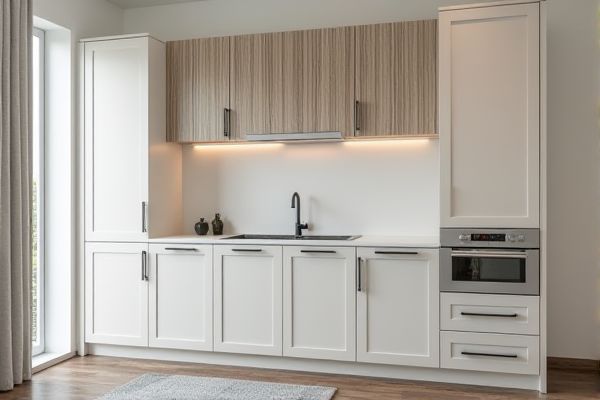
Louvered cabinets feature slatted designs that provide ventilation and a textured appearance, while flat panel cabinets offer a sleek, smooth surface ideal for modern or minimalist interiors. Explore the rest of the article to discover which cabinet style best suits Your home's aesthetic and functional needs.
Table of Comparison
| Feature | Louvered Cabinet | Flat Panel Cabinet |
|---|---|---|
| Design | Slatted, ventilated appearance | Smooth, sleek, minimalist surface |
| Ventilation | Provides natural airflow, reduces moisture | Closed surface, limited airflow |
| Style | Traditional, coastal, or rustic | Modern, contemporary, clean lines |
| Maintenance | Requires regular cleaning between slats | Easy to wipe and maintain |
| Durability | Slats may be more prone to damage | Solid panel offers greater durability |
| Cost | Typically moderate price range | Varies; often more affordable |
| Usage | Ideal for ventilation needs, laundry rooms | Suitable for kitchens and bathrooms |
Introduction to Louvered vs Flat Panel Cabinets
Louvered cabinets feature slatted panels designed to enhance airflow, making them ideal for areas requiring ventilation, such as laundry rooms or pantry spaces. Flat panel cabinets offer a sleek, minimalist design with smooth, unadorned surfaces that fit modern and contemporary kitchen aesthetics. Choosing between louvered and flat panel cabinets depends on your functional needs and style preferences, balancing ventilation with clean, streamlined looks.
Design Overview: Louvered Cabinet Features
Louvered cabinet features include slatted wooden panels that promote ventilation and add a textured, dimension-rich aesthetic to interior spaces. These cabinets are often used in humid environments such as laundry rooms and bathrooms due to their breathable design that prevents moisture buildup. Compared to flat panel cabinets, louvered models offer a distinctive style with enhanced airflow, making them both functional and visually appealing.
Flat Panel Cabinets: Characteristics and Style
Flat panel cabinets feature a sleek, minimalist design with a smooth surface and clean lines, often crafted from materials like MDF or plywood with a veneer finish. Their simple, unadorned appearance complements contemporary and modern kitchen styles while offering easy maintenance and versatility in color options. This cabinet style enhances a space's visual openness, making it ideal for small or clutter-free kitchen designs.
Ventilation and Airflow Differences
Louvered cabinets feature horizontal slats that allow continuous airflow, making them ideal for spaces requiring ventilation such as laundry rooms or kitchens. Flat panel cabinets have solid, smooth surfaces that restrict ventilation, limiting airflow and potentially leading to moisture buildup in enclosed areas. Choosing louvered cabinets significantly improves air circulation and helps prevent mold and odors compared to flat panel designs.
Aesthetic Appeal: Comparing Visual Styles
Louvered cabinets feature horizontal slats that create a textured, coastal or traditional aesthetic, offering ventilation and visual interest through shadow play and depth. Flat panel cabinets present a sleek, minimalist look with smooth, unadorned surfaces, ideal for contemporary or modern interior designs emphasizing clean lines and simplicity. The choice between louvered and flat panel styles significantly influences the overall ambiance of a space, balancing rustic warmth against modern sophistication.
Durability and Maintenance Factors
Louvered cabinets, constructed with narrow slats, offer superior ventilation and resist warping in humid environments, making them highly durable for kitchens and bathrooms. Flat panel cabinets, featuring smooth, solid surfaces, are easier to clean and maintain due to their seamless design but may show scratches and dents more visibly over time. Choosing between these styles depends on balancing the need for airflow and moisture resistance with the desire for simplified maintenance and a sleek appearance.
Cost Comparison: Louvered vs Flat Panel Cabinets
Louvered cabinets typically have higher manufacturing costs due to their intricate slatted design, which requires more labor and materials compared to the smooth surface of flat panel cabinets. Flat panel cabinets are generally more budget-friendly and easier to produce, making them a popular choice for cost-conscious homeowners. Your decision should consider both upfront costs and long-term value, as louvered cabinets can add a distinct aesthetic appeal that may enhance resale value.
Application Suitability in Home Settings
Louvered cabinets, featuring slatted designs, promote ventilation and are ideal for humid areas like laundry rooms or bathrooms, preventing moisture buildup and mold growth. Flat panel cabinets, with their sleek and smooth surfaces, suit modern kitchens and living rooms, offering a clean, minimalist aesthetic that complements contemporary decor. Choosing between them depends on balancing functional needs such as airflow and moisture control with stylistic preferences for room ambiance and design consistency.
Installation and Customization Options
Louvered cabinets offer ventilation benefits ideal for humid areas, with modular installation options allowing easy airflow customization. Flat panel cabinets provide a sleek, modern look, featuring versatile hardware choices for tailored design and straightforward installation. Your choice depends on desired aesthetics and functional needs, with both styles supporting personalized configurations.
Conclusion: Choosing the Right Cabinet for Your Needs
Louvered cabinets offer enhanced ventilation and a distinctive textured appearance, making them ideal for spaces that require airflow and a touch of architectural detail. Flat panel cabinets provide a sleek, modern look with smooth surfaces that are easier to clean and maintain, perfect for minimalist or contemporary designs. Your choice should balance aesthetic preference, functional needs, and maintenance considerations to ensure the cabinet complements your lifestyle and space effectively.
 homyna.com
homyna.com